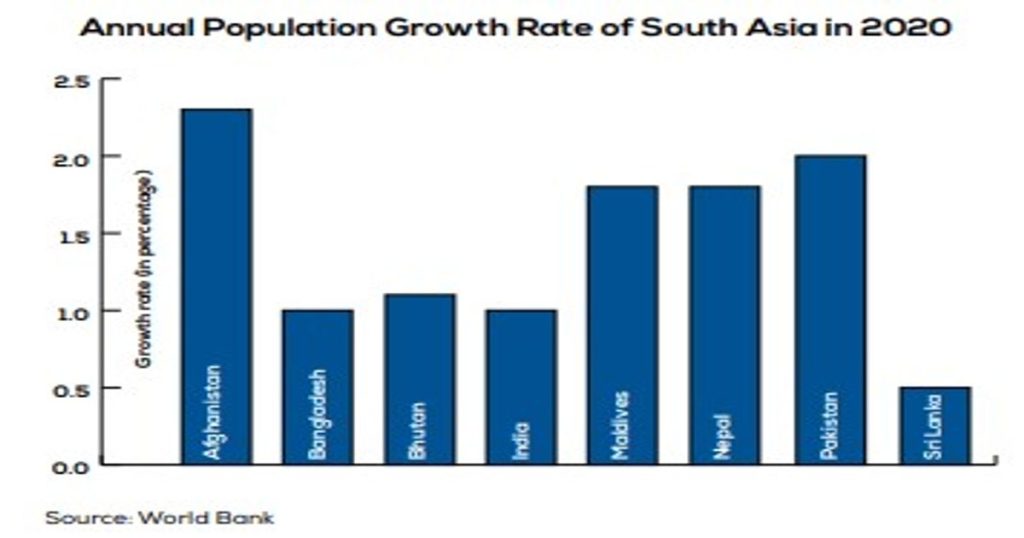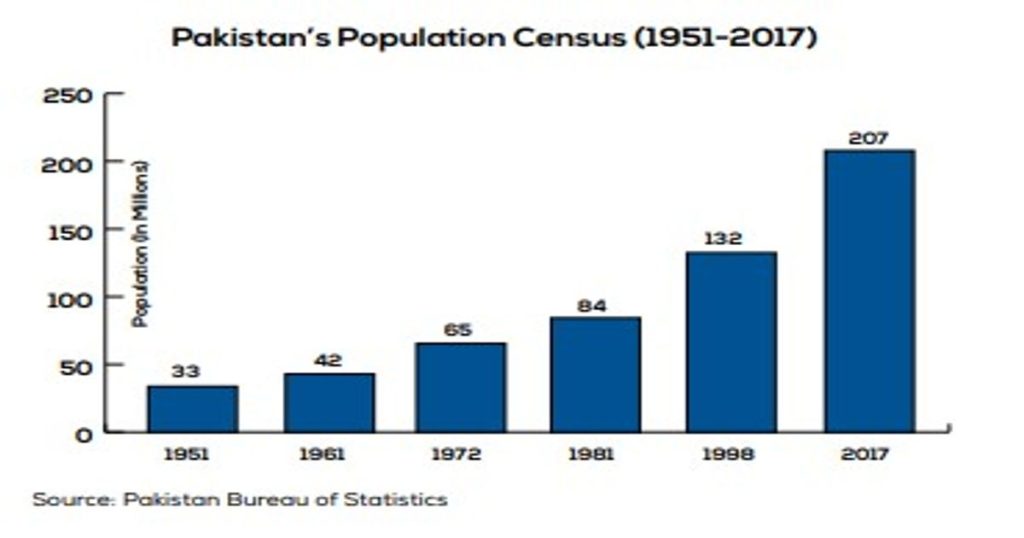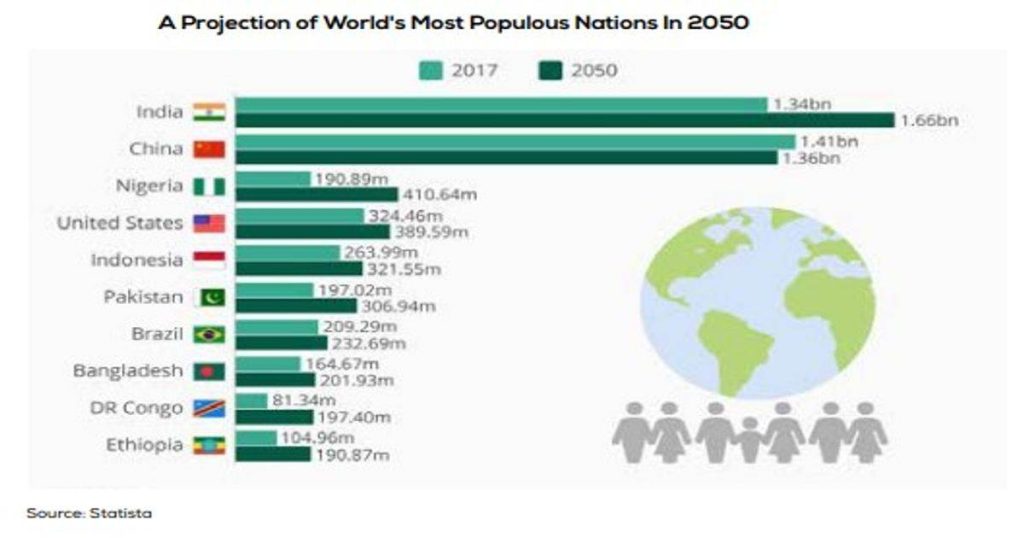Recently, a policy debate workshop was organized on population by a policy institute where my recommendations were not incorporated in the final draft. Hence, we sought to write about it independently to alert the world about the population time bomb in the South Asian region. While it is challenging to surmount this problem, it is certainly possible.
We compared Bangladesh and Pakistan’s growth rates, 1 percent and 2.9 percent, respectively, to see the effectiveness of population control policies. But before venturing into the policy matters, are there any measures as to what may be a good population size that can adequately hang in the balance?

The dictionary definition of a ‘balanced population’ is “Natural population in a particular land area or body of water that maintains itself year after year with a little fluctuation in the number of individuals despite regular fishing and hunting.” In the light of this, how have several ecological communities fared? The human population has exponentially grown to a point where the biophysical limits of the globe are threatened.
Perhaps animals deserve this planet more than we do because they are disappearing at the expense of us humans. Animals dwell within nature, but humans have increasingly dwelt outside of nature. This notion directly opposes the modernism-inspired knowledge, which insists that there is no such thing as nature; rather, a mechanical universe is composed of dead matter, which can be dominated at will and used to our advantage. There is nothing sacred about nature intrinsically. The former view looks at nature as a wife from which one benefits and towards whom one has responsibility. The latter view looks at the world of nature as a prostitute, from which one benefits but has no responsibility. This means that the spirituality of nature must be respected to coexist with nature rather than dominating nature irresponsibly.
Read more: The implications of Pakistan’s unbridled population growth
For people to sustain themselves, if people grow, then the forest must also grow, the water must also grow, and so should other resources. However, since the physical resources are more or less finite, it will eventually lead to the Malthusian dystopian condition. The new demographic parameters state that a country in its physical and financial capacity must have a certain number of people, which should be no more than that which it can provide for. These parameters are implicit in the international development indicators such as food, clean water, quality of life, etc. As pointed out by research at Srinagar University, the world population about ten years ago was overpopulated by 15 percent.

Now, if we apply those parameters of Pakistan, then it is a country for only 80 million people, not 250 million people. The 80 million figure was achieved in 1980. In 2021 the way we Pakistanis are increasing our population; we have already crossed the sustainable number.
Rural to Urban exodus
According to the last census done in 2018 by the then government, the estimated population growth was 2.9 percent. This meant we were adding about 6 to 7 million kids every year. This is beyond sustainable. Another dire thing which is very different from most of the world is that more than 50 percent of people live in villages, and rural poverty is 55 percent, against 9.5 that of urban. People that live in villages come to urban towns for work while still living in villages. Why will the 55 percent not move to a place where only nine people are poor out of 100? It would mean an exodus to the towns.
If this pace continues, then according to the figures and the statistics trends available, Pakistan would have about 320 million people by the year 2030, and out of that, 80 percent would be in the towns. From 80 percent of these 320 million is about 240 million people. Imagine 240 million people living in urban centers? What will happen? Urbanization cannot stand this; there would be no sewerage, no water supply, no schools, no hospitals, no education, nothing that can be called civic amenities. This is simply not sustainable.
According to those requirements, the world has devised policies called land-use policies for every country. The British had introduced the land use policy in the subcontinent. However, after the partition, we have forgotten that. According to that land use policy, the world should have certain areas underwater, certain regions under forests, and certain areas left fallow for future generations. A soil scientist named William Webster, an authority in soil sciences, said that “soil fertility and the land conservation is a sacred trust of the future generation.”
Read more: Why Pakistan needs to step up efforts to control its population
But the way we are expanding and consuming the land, where will the future generation that we are producing at 2.9 percent, live? President Roosevelt once said, “a nation which destroys its soils destroys itself.” We have destroyed our soil and land. Pakistan had 3.2 percent forest at the time of partition, out of which about 16 percent were in KPK. Between birth and death, humans need trees as their basic requirement for living, for basic traditional medicines, food, cloth, shelter, etc. We have lost our water sources multiplying this horrendous situation, so where is that land-use policy that demands us to have 30 percent of water? One has to realize where we are headed.
Imagine earlier times when anything that you needed was from trees? An Indian population analyst mentioned that “population is pollution and is the mother of all evils and all human diseases.” If you can control the population, you will control pollution hence controlling your National Health.
Scavenging for resources
Overpopulation is the main cause for our health expenditures, hospital shortages for big populations are inevitable, and for such a big population, the eternal super forces cannot even give full medical treatment. Even providing clean air to breathe for such a huge population will be a challenge. We do not need to research the problem of water scarcity or shortage.

This problem will recur unless the policymakers listen to the narrative and realize; the root cause of the problem is “Population.” Are they too dumb to understand the problem, or do the scientists and activists have a low tone or inability to communicate to ring the alarm of this menace? The researchable issue is that why scientists and policymakers are not on the same page.
Pakistani’s shy away from calling population a problem. There should be a population control department instead of population welfare. How is this welfare possible with this 2.9 percent increase without planning, and how can we solve the problem? What amazed, surprised, astonished, and saddened me is that we are not taking a single step despite knowing the issue entirely. I have never seen and heard any man in any position of responsibility and deliverance, including the head of state in Pakistan, declaring it a menace openly.
As far as the recommendations are concerned, I would recommend two things. The example set by China, the largest population, Sarah Lloyd, wrote in her book on Chinese connection narrating long March, “everybody used to walk with 30 to 40 miles a day with less food, and now China has the biggest problem storing rice.” Chinese have done wonders, and one wonder was implementing the one-child policy 40 years ago in the 1980s. This one-child policy has balanced the Chinese population. As a result, the average height of the Chinese has gone up by an inch, health levels have gone up, and medical expenses reduced.
Read more: Pakistan & Population Explosion: Know When its Time To Stop
Pakistan can have a one-child policy for the next 25 years to be able to achieve balance. The government needs to spend 5 percent of GDP on education for the next 15 years, specifically science, technology, math, history, economics, and logic, to make this a reality.
My suggestions here are that when a new couple gets married, poor, rich, or middle class, the government should advise them not to produce a second child during five years’ time period. The government should give them a certain amount, around 500,000 rupees. Further, if they do not produce a second child within the next two or seven years, announce a bounty of 1 million rupees for that couple. Slowly they would be used to the luxury of one child because of improved economic conditions. Incentives are the best motive for forwarding ideas, so do that. Secondly, A man with four or more children should be denied free medical, free health care, free education, etc. One-child policy for the next 25 years can only take Pakistan forward.
Manzoor Ahmad Khan, former senior advisor, The World Bank. He is also a senior scientist on agriculture and rural development projects. The writer is also a member of the American think tank group (AGMIP) on climate change policies in Afro Asian countries.


